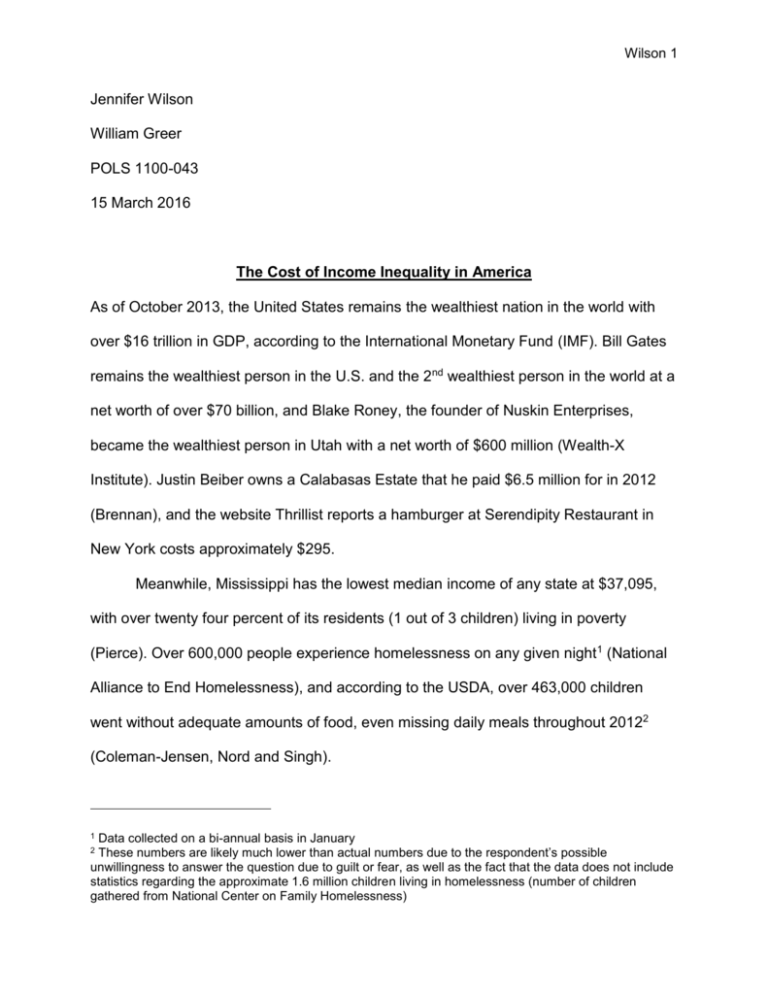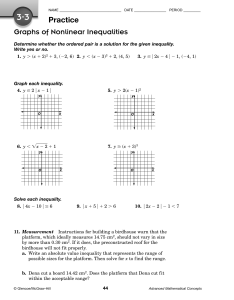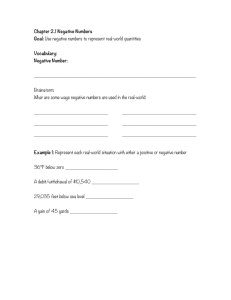Wilson Jennifer Wilson William Greer POLS 1100
advertisement

Wilson 1 Jennifer Wilson William Greer POLS 1100-043 15 March 2016 The Cost of Income Inequality in America As of October 2013, the United States remains the wealthiest nation in the world with over $16 trillion in GDP, according to the International Monetary Fund (IMF). Bill Gates remains the wealthiest person in the U.S. and the 2nd wealthiest person in the world at a net worth of over $70 billion, and Blake Roney, the founder of Nuskin Enterprises, became the wealthiest person in Utah with a net worth of $600 million (Wealth-X Institute). Justin Beiber owns a Calabasas Estate that he paid $6.5 million for in 2012 (Brennan), and the website Thrillist reports a hamburger at Serendipity Restaurant in New York costs approximately $295. Meanwhile, Mississippi has the lowest median income of any state at $37,095, with over twenty four percent of its residents (1 out of 3 children) living in poverty (Pierce). Over 600,000 people experience homelessness on any given night1 (National Alliance to End Homelessness), and according to the USDA, over 463,000 children went without adequate amounts of food, even missing daily meals throughout 20122 (Coleman-Jensen, Nord and Singh). 1 Data collected on a bi-annual basis in January These numbers are likely much lower than actual numbers due to the respondent’s possible unwillingness to answer the question due to guilt or fear, as well as the fact that the data does not include statistics regarding the approximate 1.6 million children living in homelessness (number of children gathered from National Center on Family Homelessness) 2 Wilson 2 These differences are startling, yet characteristic, of the continuing trend of income inequality in America, where those who are considered to be part of the “Top 1 percent” in regards to annual income, have seen their share of income double since 1976, due in part to changes in the tax code allowing for a narrower definition of income required to be reported and taxed, such as the 1986 Tax Reform Act (Atkinson, Alvaredo and Picketty). On the opposite end of the spectrum, the number of American’s living in poverty has continued to steadily increase as well, over the same time period3. This marked level of income inequality has been the subject of debate for many years due to differences in economic strategies and policies, and their impact on income distribution between America’s wealthiest and it’s poorest of citizens. Social programs, or lack thereof, have been ineffective at solving the problems associated with the widening income gap, where the rich are getting richer and the poor are getting poorer. With the “American Dream” disappearing for many, there are serious considerations that need to be taken into account in regards to the direction of social and economic policies that have been created in opposition. Instead of relying on policies which seem to have little to no impact on solving social problems, and instead, end up creating even more problems, there needs to be definitive measures taken. Long-term solutions that don’t include deregulation of markets, the support of predatory industry practices, and false economic recoveries, are desperately needed in order to break the cycle of volatility between those in the highest and those in the lowest of social strata. 3 United States Census Bureau, Economic Policy Institute, National Bureau of Economic Research Wilson 3 When we discuss the issues surrounding the growing income gap in America, we are typically presented with numerous facts and figures regarding such quantitative values as income, assets, net worth, property value, etc. as if they are the lone problem associated with income inequality. However, the most concerning issues that exist when there is an unusually high level of economic disparity in societies are not necessarily quantitative. These issues are those that are central to the quality of a person’s life, and can be illustrated using Maslow’s Hierarchy of Needs. They have to do with resources, which are not necessarily financial in nature. I’ve chosen to discuss two of those resources and their relationships to income inequality below, as both are considerable factors when discussing the topic. The first of the two factors I chose to look at is the relationship between health and inequality, given that a person’s health status is often considered a true measure of the quality of life in that individual. Therefore, I felt it important that we look more closely at the implications that inequity may have on it. The second factor that I chose to look at is the relationship between education and inequality. I chose education because of the strong correlation it has to a person’s future socioeconomic status and possible subsequent relationship to income inequality. It’s important to note, though, that these are just two of many aspects of life that can be adversely affected in the presence of marked income inequality. The differences in the health and wellness of the poor versus the wealthy are well documented and with the current state of healthcare costs, it is obvious that the poor are at an extreme disadvantage. In general, a lack in financial resources available for medical care puts a person at an increased risk for death from illnesses not caught Wilson 4 during routine screening. Not surprisingly, areas with increased levels of income inequality have also been associated with higher deaths related to illnesses such as coronary heart disease or malignant neoplasms, homicide, and infant mortality, to name a few and when looking specifically at mortality, one particular study found that when mortality rates in areas of high income inequality were compared with mortality rates in areas with more economic equity there was a difference of nearly 140 deaths per 100,000. Thus, studies have concluded that even a small increase in equity could have positive effects on community health (Kawachi and Kennedy) and when specifically considering mortality rates, a reduction in inequality should be considered a high priority (Lynch, Kaplan and Pamuk). It may be tempting to dismiss the evidence suggesting that income inequality promotes ill health and increased mortality by reasoning that these findings are more related to specific class, rather than relating to class and economic inequality. However, when the U.S. was compared to nations where more equity is present, there was still enough evidence to show that income inequality does play a part in the role of public health (Kawachi and Kennedy). It is fairly common knowledge that education equals opportunity and financial stability. Data gathered from the Russell Sage Foundation regarding education and future wealth shows that 55% of those who are considered wealthy report obtaining at least a 4-year degree4 and for some of them it is much easier than for others, an issue which was brought to light in an article written for the Washington Post by Catharine B. Hill, President and Professor of Economics at Vassar College. In the article, Professor 4 http://money.cnn.com/2013/09/25/news/economy/income-inequality/ Wilson 5 Hill discussed what she feels to be the biggest challenge to higher education, which is income inequality (Hill). Professor Hill explains that institutions frequently spend more for programs and facilities in order to attract and compete for students from families that can afford to “shop” for higher education. These families are more than willing to pay the increased tuition costs that this spending creates, while families who rely on financial aid remain at a disadvantage with a limited number of choices, if any at all. Ultimately, this cycle continues to perpetuate itself, so while children of the wealthy continue to be able to afford to achieve higher education, children of lower socioeconomic status continue to find themselves in a position of uncertainty when it comes to affording college which may end up not even being an option in the end, eventually contributing to the ever widening income gap that continues to flourish in America. Conclusion In this paper, I attempted to scratch the surface of two of the most concerning issues associated with income inequality. While I was unable to explore all of the issues in depth, I believe that the information that I did provide does help make it clear that there needs to be more of a balance in the United States in regards to our economic system and its ability to provide for all citizens. There are several solutions that have been discussed in order to accomplish this task, such as proposals to make changes in the tax code, decreasing the influence of money in policy making, increasing access to higher education, and providing better and more effective social programs. However, implementing policies in order to create this balance and foster more equality may be just a pipe dream. Wilson 6 Frequently, those who advocate for such changes are called Socialists or Communists, or even anti-American. Capitalism is often considered to be the pillar of American success and how dare anyone try to limit the success of a fellow man or woman (even though that success may have more to do with factors such as generational wealth, favorable economic policies, and lenient tax codes, rather than determination and hard work). Therefore, it is with this reaction in mind, that we may find it wiser to steer conversations regarding the issues surrounding the income gap away from fiscal relationships, and towards the deeper issues, such as those regarding the quality and preservation of individuals and society, instead.









